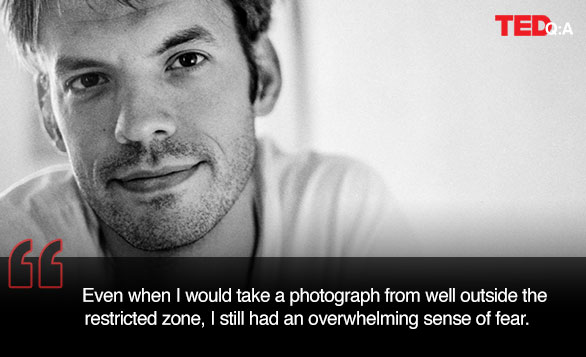 How would it feel to walk across a sunny meadow, through a quiet forest, or up a beautiful ridge, knowing all the while there might be active land mines just beneath your feet? In Minescape: Waging War Against Land Mines, Brett Van Ort—artist and photojournalist—shares photographs that document just this experience. Through his pastoral, haunting images of mine-filled landscapes, alongside photos of mines themselves and prosthetic limbs, Van Ort documents the tragedy of leftover land mines from the war in Bosnia and Herzegovina.
How would it feel to walk across a sunny meadow, through a quiet forest, or up a beautiful ridge, knowing all the while there might be active land mines just beneath your feet? In Minescape: Waging War Against Land Mines, Brett Van Ort—artist and photojournalist—shares photographs that document just this experience. Through his pastoral, haunting images of mine-filled landscapes, alongside photos of mines themselves and prosthetic limbs, Van Ort documents the tragedy of leftover land mines from the war in Bosnia and Herzegovina.
We sat down with Van Ort to learn more about the global crisis of land mines and what we can all do about it.
What first got you interested in the land mine crisis?
It was a slow progression. It started with my interest in modern man’s impact on the topography of the physical landscape. In 2009, I wanted to find landscapes that still harbored fear and limited movement much the way forests, mountains and rivers inhibited development many centuries ago. After some thought, the idea of minefields and how they restrict movement came to me. To get at the core of that, I decided to photograph the actual fields where the devices were embedded. From there, I learned much more about the topic. As a result, I usually include information in my talks about what we can do to stop creating and using these devices.
What are the impacts land mines have on a country after a war is over?
Obviously, land mines kill and maim. But land mines also restrict movement, discourage agricultural and economic development, and break down the necessary social interaction between neighboring communities. They also affect families — an entire family unit must learn to care for the survivor and aid in chores while he/she is seeking constant medical attention.
Of all the countries affected by land mines, why were you drawn to Bosnia and Herzegovina?
After the war ended in 1995, Bosnia had the highest proliferation of mines in the earth. There were 152 mines per square mile, according to Human Rights Watch in 1996. Today, about 2.8% of the land area is considered a minefield.
Also, I felt the audience needed to have a connection to the landscape. Afghanistan, Angola, Egypt and Iraq, with their desert locals, and Cambodia, Colombia and Laos, with their jungles and rice patties, seem distant and foreign to majority of Americans and Europeans. Westerners can relate to the Bosnian landscape. The Dinaric Alps resemble the Sierra Nevada. With lush, coniferous canopies, these areas closely resemble the places we walk with our dog or family in the early evening during summer.
Did you feel in danger when you were walking around these mine fields?
Yes. The width of the safe space is delineated by caution tape on the ground. That space is no more than the width an airplane aisle in some spots. It feels as if you are on a tight rope. Even when I would take a photograph from well outside the restricted zone, I still had an overwhelming sense of fear.
How is technology aiding land mine eradication?
The metal detector, along with a thin metal probe and a trowel, is still the preferred method for removal. However, there are land mine removal “tanks” that chew up the ground and set off the land mines in the process. The British military designed a Python Minefield Breaching System — a rocket is shot out attached to a 200 yard cord, which, after it is laid, carries a charge which will detonate every mine within a seven meter-wide area. Then there are mine sniffing dogs and the HERORats from Mozambique that can smell out the TNT in a mine. Lastly there is Mahmoud Hassaini’s Mine Kafon. The wind-blown, tumbleweed-like device, costs about 40 Euros and can detonate several mines in a single pass across a plain. Specifically, the Mine Kafon device allows for locals to inexpensively survey an area to see if their suspicions are correct.
What else can be done to eradicate land mines globally? What can we do?
The first thing we can do as Americans is pressure our representatives in Congress to ratify and sign the Anti-Personnel Mine Ban Convention Treaty, a.k.a. The Ottawa Treaty. We need to join in condemning and outlawing these indiscriminate killing machines.
Supporting local NGOs that do work supporting mine victims is another step. However, passing the word on and telling your friends and family to pressure their representatives is the most direct action we can take. If the United States can formally ratify the treaty and sign it, then hopefully this will put pressure on states like Russia, China, India and Pakistan.
Minescape is available for Kindle and Nook, as well as through the iBookstore. Or download the TED Books app for your iPad or iPhone.
Comments